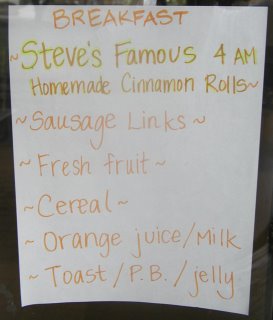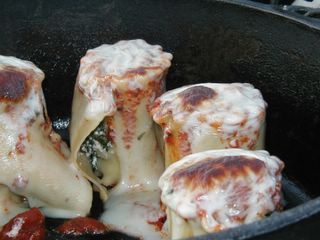I wrote this article while camping in Oregon's Diamond Lake 10 years ago. It ran in the fall 2004 issue of the IDOS Dutch Oven News
. It was written from the perspective of fall camping. With fall quickly approaching, why not give it a try?
Do you remember the last time you stood around a glowing fall campfire? Your backside froze in the crisp autumn air while your front roasted. To equalize the radiant energy of the campfire, you’d momentarily turn your back to the fire. But soon, your front would freeze and you’d once again turn to face the fire.
The autumn campfire gives fall campers the perfect opportunity to cook a favorite among camp dishes. So, why waist a good campfire? Prepare three-sided chicken for dinner with your next fall campfire. Like the two-sided effect of the campfire, a whole chicken fryer roasts on three sides (top, bottom and the side facing the fire) in a deep-model Dutch oven.
Three-sided cooking in camp
Next time you light a campfire on a fall camping adventure, clear a spot in front of the fire for a large Dutch oven. Meanwhile, slip a jacket on to keep your back warm, step over to the chuckbox and rub a fresh four to five pound chicken fryer your favorite seasoning. Once the campfire burns to a nice bed of coals, you’re ready to cook.
You’ll need a large campfire to produce sufficient coals to boost the oven to an estimated internal temperature of 375 degrees to 400 degrees F. The hot oven turns the skin to a crisp golden brown and the breast meat to a succulent juiciness when cooked just right. To evenly brown the bird, apply heat to three sides of the oven. Top, bottom and backside heat creates a bird with perfectly browned skin.
To start, burn a large campfire until a hot, glowing bed of coals remains. This’ll take 30 to 60 minutes, depending on the available wood. Then clear a shallow pit in front of the fire that’s the approximate diameter of a 12-inch Dutch oven. When ready, use a shovel to transfer hot coals to the pit and pre-heat the Dutch oven over the bed of coals.
Since you don’t want to set the chicken onto the floor of the oven, place a round baking rack or Dutch oven trivet in the oven. (Don’t have a trivet? Set the chicken on a bed of roughly chopped onion, carrot and celery.)
Place the seasoned chicken on the rack or trivet. Then place the lid on the oven and shovel a heap of coals over the Dutch oven. It’s this blast of heat that’ll radiate to the skin and transform the chicken into a delicious meal.
The problem with three-sided cooking is that the fourth side languishes without intense heat. It sets at sub-roasting temperatures while the side that faces the fire sizzles dangerously close to carbonization. To ensure even cooking, frequently turn the Dutch oven. At the same time, rotate the lid in the opposite direction. This’ll compensate for the uneven cooking of the coals.
If you haven’t done so already, add fresh firewood to the fire. Heat from the flame and the coals of the fire will radiate to the exposed side of the oven. Next time that you lift the lid, you’ll notice the skin and juices sizzling toward a simple meal.
Senses become your doneness meter
I can’t tell you how long you’ll be able to face the fire before you must turn your body. Each person comes to the campfire with his own tolerances for heat and cold. This is where you’ll have to depend on experience––both as a camper and cook.
Nor can I tell you how many coals that you’ll need to heat the oven to 375 degrees F. Just pile fresh coals on the lid of the oven as often as needed to maintain oven temperature. Experience will teach you how many coals to add to the pot.
Your senses will become your thermometer and doneness indicator. You’ll have to gauge temperature by watching the chicken cook. (Is the skin sizzling or sitting limp? Has the skin started to brown within 20 to 30 minutes?) Since you don’t want to lift the lid too often, listen for cooking sounds (can you hear the sizzle?). And as the chicken cooks, satisfying aromas will waft up to you.
All three--browning action, sizzle and aroma--work together to help you assess the bird’s progress and ultimate doneness. To gauge doneness, simply pull one leg from the body. If it gives with an effortless twist and the juices run clear, the chicken is done. It’ll take 1-1/4 to 1-1/2 hours to roast the chicken.
The key is to cook the chicken just until it’s done––not a minute longer. Overcook the bird and you’ll be rewarded with dry meat. You’ll need a quart of gravy to make the meal palatable. And remember, if it smells burnt, it is.
For a complete meal, add Yukon Gold or Klondike Rose potatoes to the pot about 45 minutes before the chicken is done. One or two small potatoes per person should do. Or cool the chicken slightly and pull the meat off of the bone. Then wrap in flour tortillas with Spanish rice, salsa and sour cream.
Plan to cook three-sided chicken on your next fall camping adventure. Follow these simple techniques and you’ll be rewarding with one of the simplest Dutch oven meals that you can produce in camp. You’ll need a jacket to warm your back and a campfire to heat your front and roast the chicken.
The softwood solution
I depend on downed softwood in the Sierra Nevada high country to build my campfires. To me, it’s a waste of precious dollars to haul oak firewood or charcoal briquettes to the campground. I instead rely of the natural resources of the forest.
I’ve learned that to be successful with softwood you must pay constant attention to your Dutch oven. Pine, fir and cedar burns quickly. As a result, you need watch your oven and replenish the coals often.
I don’t focus oven temperature when camping. I just pile hot coals from the campfire onto the oven with a gloved hand and a pair of 14-inch tongs. I use experience and the five senses to approximate the correct number of coals.
I usually build a campfire that’s four to five times the volume of the camp oven and burn it down to a glowing bed of coals. You can accomplish this in approximately 30 minutes with pine, fir and cedar.
I've learned from many poorly cooked dishes that you can never have too many campfire coals. To make sure I finish the dish with sufficient heat, I continue to feed the campfire even after I’ve heated the oven. I keep feeding the fire as long as I have a plentiful supply of firewood.
TIPS FOR A PERFECTLY ROASTED CHICKEN
- Don’t truss the chicken. Though recommended by chefs, trussing forces the breast up into the oven’s head space. This reduces the likelihood that the chicken will brown properly.
- Rotate the Dutch oven often. For a perfectly browned chicken, rotate the oven in increments. You have to judge how often based on experience and observation. As the skin in the first section browns, give the oven a 45- to 90-degree turn to brown the next section.
- Think food safety. A bout of Salmonella is the last thing you want in camp. Freeze the bird at home. Then wrap it in two sheets of newsprint and enclose it in a large zipper-lock bag. And thoroughly scrub your hands in warm soapy water after handling the chicken.
















































